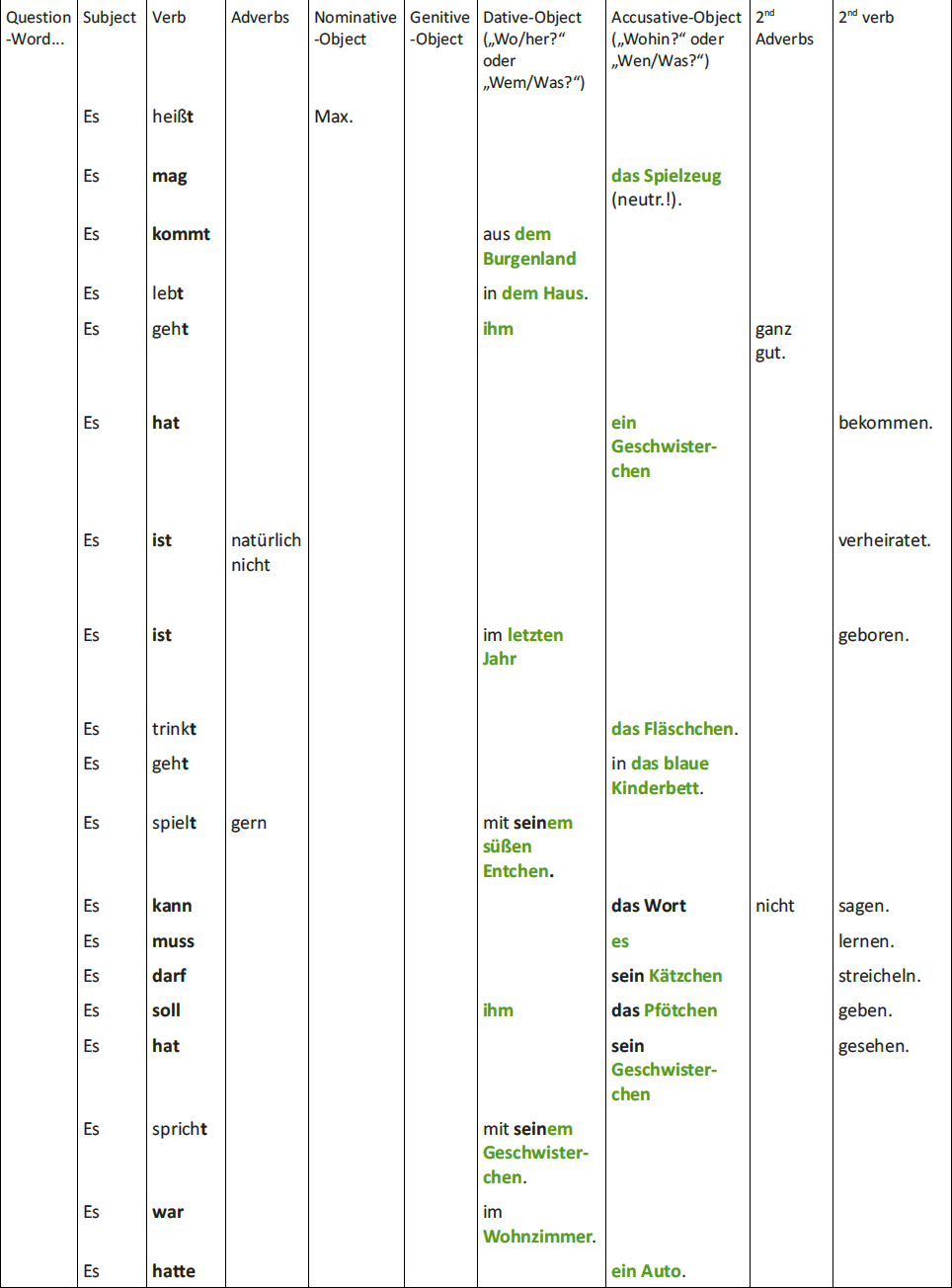


 You are going to Learn:
You are going to Learn:  Common phrases,
Common phrases,  how to express facts with neuter nouns and pronouns,
how to express facts with neuter nouns and pronouns,  the third person singular,
the third person singular,  a lot of new vocabulary …
a lot of new vocabulary …
Maybe some of the aspects and the concept of German may sound strange to you – if you compare them to your mother tongue or the English language, for example: But we have to make a strict distinction between the natural gender and the grammatical gender in German! Following a “concept of natural gender” all objects, “things” would be neuter, and all “persons”, animals … depending on their sex would be masculine or feminine. But unfortunately, the German language does not follow this concept! For many reasons – we have to accept that - a table is not neuter but masculine (“der Tisch” or “er”), a bag is not neuter but feminine (“die Tasche“”or “sie”), but a girl or a baby is (“das Mädchen”, “das Baby” or “es”)! This may sound illogical, but proves the fact that the German language is a highly elaborated one with a long history, and it has been influenced by different other languages. Last but not least, German is “die Sprache der Dichter und Denker” - “the language of the poets and thinkers”!
So, you have to take the challenge and study each noun
The good news is: You are going to find all these forms inside your dictionary supplemented with this information! What does this mean especially for this chapter: For instance, our baby and the sibling are NOT masculine or feminine – whether they are a girl or a boy. The grammatical rule tells us that they are NEUTER (“it” = “es”! Just accept this and you will stay happy ;).
Max, the baby, “likes the neuter gender”. This simply means that this chapter focusses on
Don´t mind, if you do not exactly UNDERSTAND this concept! I guess that even a lot of German natives and perhaps also teachers don´t! :) Nevertheless, if you are willing to study these sentences by heart, you are going to internalize and recognize important phrases and structures in a very natural way. So, let us find out more about our third person neuter, about Max:
„Es“ (= the third person singular „It“):
Question-Word… |
Subject |
Verb |
Adverbs |
Nominative-Object |
Genitive-Object |
Dative-Object („Wo/her?“ oder „Wem/Was?“) |
Accusative-Object („Wohin?“ oder „Wen/Was?“) |
2nd Adverbs |
2nd verb |
|
Es |
heißt |
|
Max. |
|
|
|
|
|
|
Es |
mag |
|
|
|
|
das Spielzeug (neutr.!). |
|
|
|
Es |
kommt |
|
|
|
aus dem Burgenland |
|
|
|
|
Es |
lebt |
|
|
|
in dem Haus. |
|
|
|
|
Es |
geht |
|
|
|
ihm |
|
ganz gut. |
|
|
Es |
hat |
|
|
|
|
ein Geschwisterchen |
|
bekommen. |
|
Es |
ist |
natürlich nicht |
|
|
|
|
|
verheiratet. |
|
Es |
ist |
|
|
|
im letzten Jahr |
|
|
geboren. |
|
Es |
trinkt |
|
|
|
|
das Fläschchen. |
|
|
|
Es |
geht |
|
|
|
|
in das blaue Kinderbett. |
|
|
|
Es |
spielt |
gern |
|
|
mit seinem süßen Entchen. |
|
|
|
|
Es |
kann |
|
|
|
|
das Wort |
nicht |
sagen. |
|
Es |
muss |
|
|
|
|
es |
|
lernen. |
|
Es |
darf |
|
|
|
|
sein Kätzchen |
|
streicheln. |
|
Es |
soll |
|
|
|
ihm |
das Pfötchen |
|
geben. |
|
Es |
hat |
|
|
|
|
sein Geschwisterchen |
|
gesehen. |
|
Es |
spricht |
|
|
|
mit seinem Geschwisterchen. |
|
|
|
|
Es |
war |
|
|
|
im Wohnzimmer. |
|
|
|
|
Es |
hatte |
|
|
|
|
ein Auto. |
|
|

Translations of the sentences above:
His name is Max.
He likes the toys (neuter!).
He comes from Burgenland.
He lives in the house.
He is quite fine.
He has a sibling.
He is of course not married.
He was born last year.
He is drinking the baby bottle.
He goes to the blue child´s bed.
He likes playing with his sweet duckling.
He cannot say the word.
He must learn it.
He may caress his kitten.
It shall give him the paw (Here we have a change of perspective!).
He has seen his sibling.
He speaks with his sibling.
He was in the living room.
He had a car.